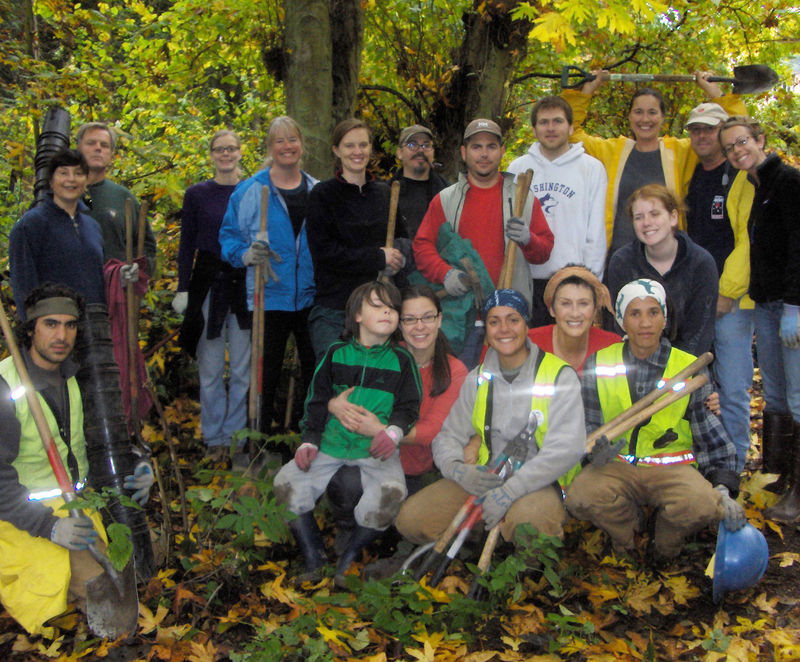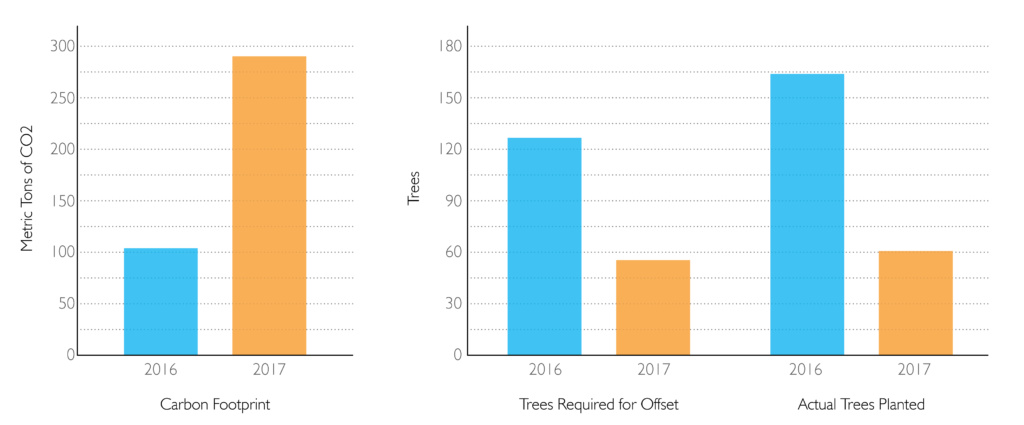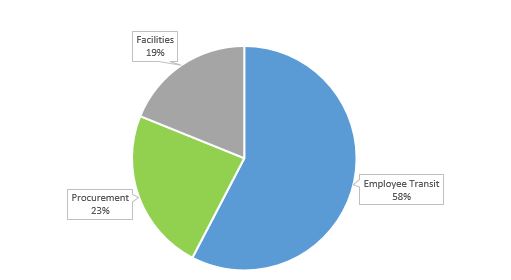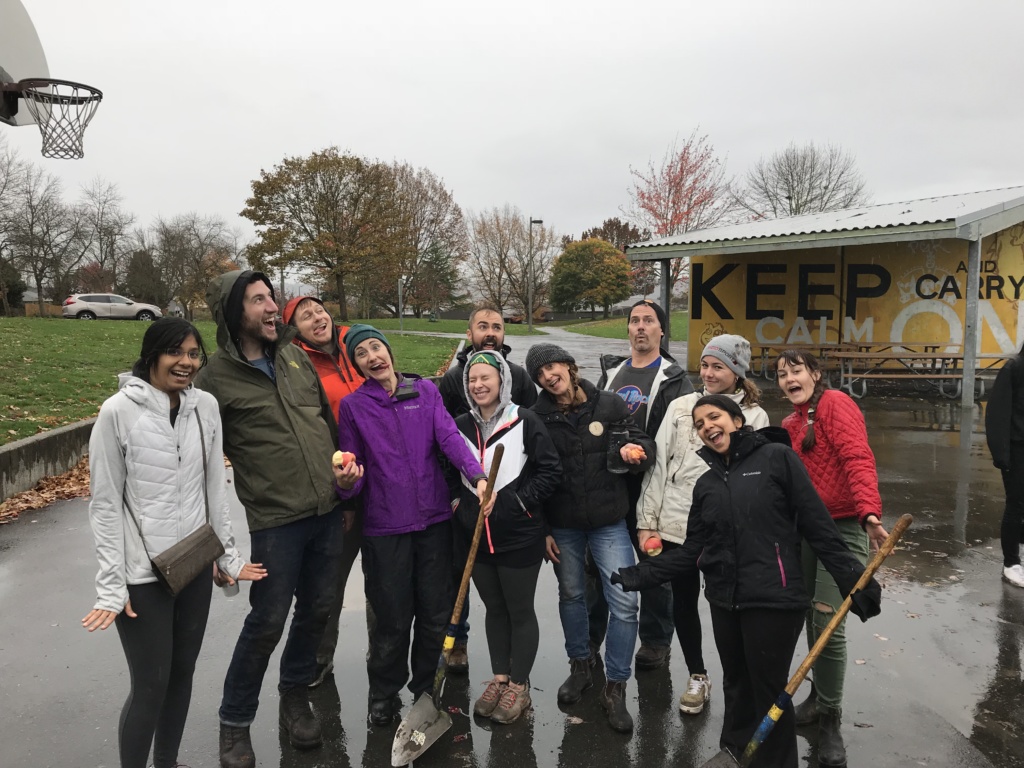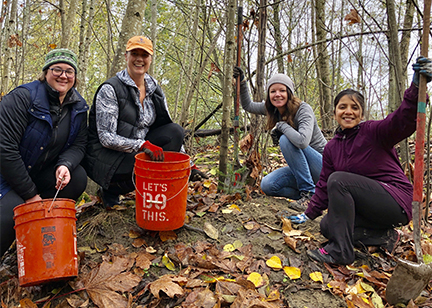As part of Weber Thompson’s Sustainability Action Plan, we have a long term goal of achieving carbon neutrality in our office operations. This goal requires balancing a measured amount of carbon released with an equivalent amount sequestered or offset. As a signatory to the AIA 2030 Commitment, we are required to improve our office operations, which helps make us passionate about this commitment to sustainability in our daily lives, and be a model for how we want our built projects to perform.
10 years ago, Weber Thompson’s Green Team completed the first calculation of WT’s carbon footprint using data from our staff’s commuting, work related air travel, and electricity used in the office for the calendar year 2007. Then, the office partnered with EarthCorps to plant native trees and shrubs at in North Seattle and Kirkland to offset our calculated carbon footprint.
We continue this tradition today, offsetting our 2017 carbon impact in 2018. This year, we expanded the scope of what was included in our 2017 calculation in comparison to the 2016 calculation.
2017 carbon output calculation categories:
- Staff commuting
- Work related air travel
- Building electricity and gas use
- Paper used – both in house printing and out of house printing (new)
- How much waste the office produced – including trash, recycling, and compost (new)
- Procurement – a catchall for items that were purchased for use in the office during the year including computer equipment, plastic products, soaps, paper towels, office accessories, etc. (new)
Comparing 2016 to 2017
In gathering this information to input into the carbon calculator, some interesting findings arose along the way. Comparing our 2016 and 2017 carbon footprint, it is clear that our total footprint more than doubled, not because of any specific change in our behavior but because of the additional activities we are now including in the calculation.
We found that our footprint from in-house paper usage alone increased by 63% from 2016 to 2017 – from 2.2 metric tons of CO2 to 3.5 metric tons in 2017. This is a result of a couple of things. First, we began using less recycled paper in 2017. Non-recycled paper has a much larger carbon footprint than partially or 100% recycled paper. To help combat this increase, we now stock the printing room with recycled paper and have placed it close to the printer. Second, with the increased scale of some new projects, the associated documentation sets became bigger which upped the paper consumption.
From the staff commuter survey 2017, we found that:
- 31% of trips are made driving alone
- 34% are made using public transportation
- 8% are via biking
- 28% of trips are made by walking.
While driving alone takes up the highest share in the total mileage (40%), more trips in our firm are made using public transit. We are excited that there are more employees relying on public transportation than any other mode of transport! This is important because of the share of our carbon footprint that is related to transportation. The split of our carbon footprint between facilities, procurement, and transit is:
We chose the Forterra business carbon calculator because it aligns well with our business operations in terms of its parameters and customization tools. We are also excited to support Forterra, a local land trust working to “help communities harness the power of the land for good.” Using their calculator, we found that Weber Thompson’s 2017 Carbon Footprint is 278 Metric tons of CO2 (or 307 tons of CO2). Forterra’s calculator tells us that this is 64.5% better than similar sized businesses of same sector in our location.
Forterra recommended using The Center for Urban Forest Research (CUFR) Tree Carbon Capture to translate our carbon footprint into number of trees to be planted. This tool is the only approved tool by Climate Action Reserve’s Urban Forest Project Protocol.
CUFR’s carbon sequestration conversion is: 1 tree planted = 5 Metric tons of CO2.
This estimation is based on local tree planting practices and survival rates of these trees. This means that Weber Thompson needs to plant 56 trees to offset our 278 Metric tons of CO2 for the year 2017. So, while our total carbon impact increased for 2017, our tree planting target decreased, because we were using a much more conservative calculation for the tree carbon capture. The good news: we believe that the CUFR conversion is more defensible, and something we can use moving forward, year after year.
Offsetting our carbon footprint one tree at a time
On November 3rd, our staff participated in Green Seattle Day at Maple Wood Playfield in Beacon Hill to begin planting our trees to mitigate our 2017 carbon footprint. During this event, we successfully planted 35 of our 56 tree target! That included Oregon White Ash and Sitka Spruce trees as well as black gooseberry, clustered wild rose and thick-headed sedge (which we did not include in the calculation but acknowledge that shrubs, grasses, and groundcover also provide ecological benefit).
We continued this effort in December 1st at Camp Long in West Seattle where we planted 24 more trees to bring us to a grand total of 59 trees! Not only are we working to offset our carbon, but we’re getting out into Seattle parks and having a great time.
